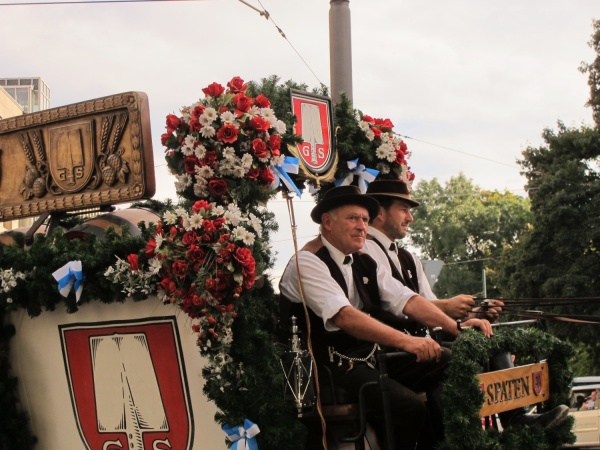Difference between revisions of "Spaten"
| Line 7: | Line 7: | ||
[[File:Waldwirtschaft Grosshesselohe 007.jpg|600px]] | [[File:Waldwirtschaft Grosshesselohe 007.jpg|600px]] | ||
| − | In 1872, Spaten made history by introducing a light-coloured Vienna-style beer at Munich's Oktoberfest. The Märzenbier which was sold in the Schottenhamel Festzelt became an instant success as other beer supplies ran out. The Märzenbier was originally permitted to be brewed only between St. Michael's Day (29th September) and St. Georg's Day (23rd April) and had to be stored in ice cellars until the Oktoberfest. Märzenbier, also known as Oktoberfestbier, is a slightly stronger Helles (lager). | + | In 1872, Spaten made history by introducing a light-coloured Vienna-style beer at Munich's Oktoberfest. The [[Märzenbier]] which was sold in the Schottenhamel Festzelt became an instant success as other beer supplies ran out. The Märzenbier was originally permitted to be brewed only between St. Michael's Day (29th September) and St. Georg's Day (23rd April) and had to be stored in ice cellars until the Oktoberfest. Märzenbier, also known as [[Oktoberfestbier]], is a slightly stronger Helles (lager). |
| − | In 1922, Spaten, Franziskaner and Löwenbräu unified into one company. In 1972, the group issued public stock for the first time. Through mergers and acquisitions that followed, the German brewery eventually became part of the Belgian-Brazilian Interbrew ( | + | In 1922, Spaten, [[Franziskaner]] and [[Löwenbräu]] unified into one company. In 1972, the group issued public stock for the first time. Through mergers and acquisitions that followed, the German brewery eventually became part of the Belgian-Brazilian Interbrew ([http://www.ab-inbev.com InBew]) giant. |
Spaten brands include Spaten Münchner Hell, Spaten Oktoberfestbier and Spaten Pils. | Spaten brands include Spaten Münchner Hell, Spaten Oktoberfestbier and Spaten Pils. | ||
Revision as of 17:04, 16 January 2013
Spaten is one of Munich's six major beer brands. Its beer brewing history dates back to 1397 when a brewer named Hans Welser set up a brewery in central Munich, originally named Welser Prew.
The ownership of the brewery changed hands many times until 1807 when the royal Hofbräu brewmaster, Gabriel Sedlmayr, took over what was then Munich's smallest brewery named Spatenbräu. The still today used logo with a spade symbolising a malt shovel bears his initials. Sedlmayr's sons continue to run the business and in 1867 Spaten became the largest brewery in Munich, as then measured by malt use.
In 1872, Spaten made history by introducing a light-coloured Vienna-style beer at Munich's Oktoberfest. The Märzenbier which was sold in the Schottenhamel Festzelt became an instant success as other beer supplies ran out. The Märzenbier was originally permitted to be brewed only between St. Michael's Day (29th September) and St. Georg's Day (23rd April) and had to be stored in ice cellars until the Oktoberfest. Märzenbier, also known as Oktoberfestbier, is a slightly stronger Helles (lager).
In 1922, Spaten, Franziskaner and Löwenbräu unified into one company. In 1972, the group issued public stock for the first time. Through mergers and acquisitions that followed, the German brewery eventually became part of the Belgian-Brazilian Interbrew (InBew) giant.
Spaten brands include Spaten Münchner Hell, Spaten Oktoberfestbier and Spaten Pils. Spaten beer can be found in the following beer gardens:
- Franziskaner Garten
- Gasthaus Siebenbrunn
- Gasthof Feringasee
- Hirschau
- Kugler Alm
- Landgasthof Langwied
- Maxhof
- Sankt Emmeramsmühle
- Viktualienmarkt
- Waldwirtschaft Großhesselohe
- Wirtshaus Zamdorfer
At the Oktoberfest, Spaten is sold in Schottenhamel, Ochsenbraterei, Hippodrom and Glöcke Wirt.
Additional information
- http://www.steincollectors.org/library/articles/Hupp/Spaten.html
- Spaten Brewery history
- http://en.wikipedia.org/wiki/InBev_brands
- http://www.bierspot.de/bierlexikon/biersorten/maerzen_maerzenbier_20.html
- http://www.kleine-wiesnzelte.de/kleine-wiesnzelte/bayerische-spezialitaeten-haxn-wuerstl/gloeckle-wirt.html

